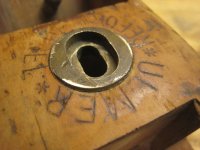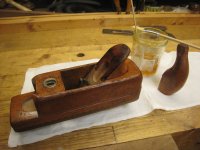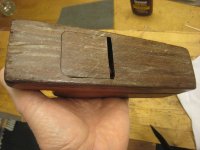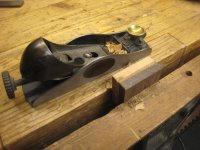When I visited my very generous friend Peter the other day, he insisted on giving me some really good tools.
One of them was this plane:

If you are anything like me, you'll notice several things about it. One is that it's a German design, with the distinctive "horn" for the left hand, to guide and pull the plane. It's a design that looks odd if you're not used to it, but if you can pick up a horned plane and try it out, it immediately makes sense and feels completely sensible and practical.
Another obvious point is that it's looking a bit sorry. Some previous owner (not Peter) has been at it with coarse sandpaper and removed all the old finish, rather crudely. There's no significant damage, but it needs a little TLC. That actually makes it a better present - I can have fun getting it to a nicer state of health. This afternoon, I started.
First though, a quick historical note. This pattern - the "Reform" plane - dates back to 1894. Its special feature is that it has an adjustable mouth, which is unusual on a wooden plane. Here's the underside. You can see that the mouth is set pretty fine at the moment; this is a smoother for taking fine shavings only, and the adjuster will cope with any wear during use.

The mouth is secured by a screw on the top:

They rapidly became popular and were copied by other makers. There's a full history on Wolfgang Jordan's website, which is the source of almost all my knowledge of continental planes. My plane resembles one in the 1930 catalogue but is not necessarily that old; it's hard to tell. You can still buy them - eg from Dictum for nearly £200.
Although the rough sanding is the most obvious issue, the front horn was missing a bit at the top and was a bit wobbly. It had also picked up a streak of black paint.

It was easy to remove the adjuster and knock the body away from the horn. Although the glue had failed, the sliding dovetail joint was a very good fit.
Inside the adjuster there was a clear assembly number, as you'd expect from a fitted part.

and here is the horn coming away:

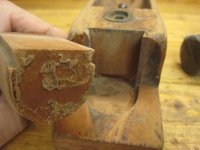
On the surfaces, I mostly used a cabinet scraper. I wanted to get a smooth surface while taking away the very minimum amount of material.
The sides of the body have a nice decorative bead detail, but the sanding had flattened it out and spoiled it. It won't affect the performance, but I put that right like this:


On the rest of the body, I mainly used 3M open mesh abrasive - the sort that resembles pan scourers - in medium and fine grades.
One other non-functional detail that bugged me was that the previous sanding had scratched at the brass surround for the adjusting screw, leaving patches of bare brass:

Fixing that was really easy - a fine paintbrush, a bottle of cold patinating fluid and a few seconds wait - but my 10 image limit is up and it's time to go and eat, so on that cliffhanger I'll leave the story for now. Back soon, so don't worry!
One of them was this plane:

If you are anything like me, you'll notice several things about it. One is that it's a German design, with the distinctive "horn" for the left hand, to guide and pull the plane. It's a design that looks odd if you're not used to it, but if you can pick up a horned plane and try it out, it immediately makes sense and feels completely sensible and practical.
Another obvious point is that it's looking a bit sorry. Some previous owner (not Peter) has been at it with coarse sandpaper and removed all the old finish, rather crudely. There's no significant damage, but it needs a little TLC. That actually makes it a better present - I can have fun getting it to a nicer state of health. This afternoon, I started.
First though, a quick historical note. This pattern - the "Reform" plane - dates back to 1894. Its special feature is that it has an adjustable mouth, which is unusual on a wooden plane. Here's the underside. You can see that the mouth is set pretty fine at the moment; this is a smoother for taking fine shavings only, and the adjuster will cope with any wear during use.

The mouth is secured by a screw on the top:

They rapidly became popular and were copied by other makers. There's a full history on Wolfgang Jordan's website, which is the source of almost all my knowledge of continental planes. My plane resembles one in the 1930 catalogue but is not necessarily that old; it's hard to tell. You can still buy them - eg from Dictum for nearly £200.
Although the rough sanding is the most obvious issue, the front horn was missing a bit at the top and was a bit wobbly. It had also picked up a streak of black paint.

It was easy to remove the adjuster and knock the body away from the horn. Although the glue had failed, the sliding dovetail joint was a very good fit.
Inside the adjuster there was a clear assembly number, as you'd expect from a fitted part.

and here is the horn coming away:


On the surfaces, I mostly used a cabinet scraper. I wanted to get a smooth surface while taking away the very minimum amount of material.
The sides of the body have a nice decorative bead detail, but the sanding had flattened it out and spoiled it. It won't affect the performance, but I put that right like this:


On the rest of the body, I mainly used 3M open mesh abrasive - the sort that resembles pan scourers - in medium and fine grades.
One other non-functional detail that bugged me was that the previous sanding had scratched at the brass surround for the adjusting screw, leaving patches of bare brass:

Fixing that was really easy - a fine paintbrush, a bottle of cold patinating fluid and a few seconds wait - but my 10 image limit is up and it's time to go and eat, so on that cliffhanger I'll leave the story for now. Back soon, so don't worry!

